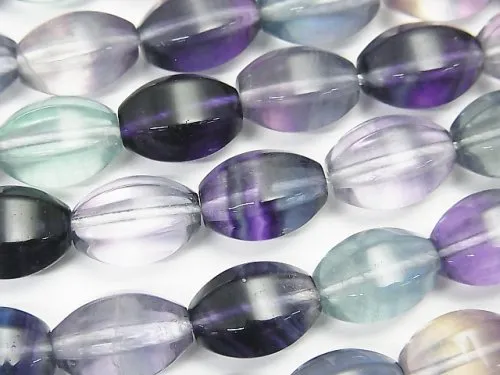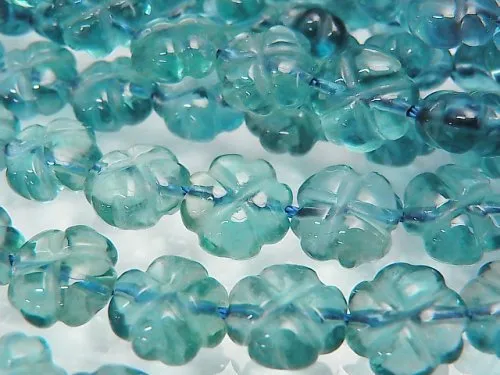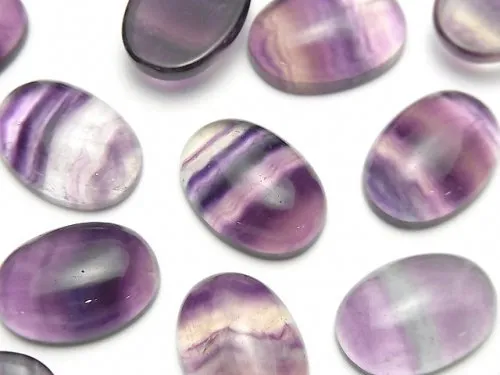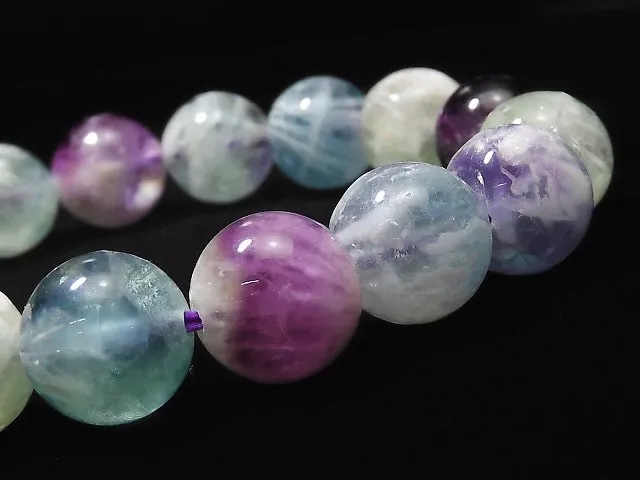Fluorite Property
Fluorite is a semi-transparent mineral with most often green, purple, blue, or yellow as color.Its name originates from the Latin "fluere" which means melting or sticky. The name of fluorine and the phenomenon of fluorescence derived from the name of this mineral, already known in antiquity by Greeks, Romans, and Egyptians. They used it for the creation of multicolored vases, statues, and sacred sculptures.Features of Fluorite Beads
Recently viewed
Fluorite - Beauty That Kills
- 1. Fluorite
- 2. Fluorite History and Significance
- 3. Fluorite Metaphysicochemical Properties
- 4. Fluorite Types
- 5. Fluorite Healing Properties and Magical Properties
- 6. Fluorite for Sale
Fluorite
The beauty of this stone has taken many lives. Everyone who tried to figure out its composition died in terrible agony. German miners gave this mineral the fabulous name ‘ore flower’. Medieval alchemists dubbed it ‘Satan's mineral’. Commoners used to call it a ‘fake emerald’. Among gemologists and gem collectors, the gem is known as fluorite.
Fluorite History and Significance
Due to the fact that people tried but could not figure out its essence, fluorite gained a reputation as a cryptic and odd stone. It often pretends to be ruby, sapphire, and many other precious gems because its color range is extremely diverse. Sometimes the same specimen shows a few hues at once. Therefore, until the mid-16th century, fluorite was confused with a handful of minerals.
The ability to glow when heated reinforced its reputation as a mysterious gem. Alchemists who tried to investigate this amazing feature quickly died. It is said that they started losing their teeth and hair and their bones became very fragile. Many experiments ended up with explosions and fires. There could be one explanation for the many deaths and disasters at that time. Medieval scientists decided that the devil himself guarded the secrets of the stone; hence they treated it with caution. Sorcerers, on the other hand, took advantage of these properties. Their clients were vying to cast a glance at Satan’s stone.
Only at the end of the 18th century, the mineral ceased to be terrifying. A Swedish chemist explained that the reason for so many tragedies was poisonous gas that the gem released when heated or introduced to acid. Then the mineral got its current name– the Latin word ‘fluor’ stands for flow.
Fluorite is widely used in industry, especially in the production of glass, lenses, and even night vision devices. In ancient

Fluorite Metaphysicochemical Properties
Fluorite, which is basically calcium fluoride, offers a wide range of colors from completely colorless to black. Its colors are heterogeneous meaning there are transitions from dark hues at the edges to light ones in the center. Oftentimes, the gemstone features spots and streaks with a smooth flow of colors. Most commonly, the stones are blue and purple. Yellow, red, and green varieties are also widespread. The rarest are colorless and pink specimens. Fluorite’s color depends on the content of admixtures and the place of extraction. Regardless of the color, fluorite crystals have a greasy, glassy sheen.
The gem has only 4.0 on the Mohs scale, which means it is soft and can be easily scratched. You should handle it with caution and avoid exposure to chemicals, especially acids because the mineral can release toxic hydrogen sulfide. Fluorite glows in ultraviolet light, when being heated, and under radioactive radiation.

Fluorite Types
There are a few trade names and varieties based on their chemical composition and appearance:
Ratovkit is a grainy mineral offering purple and violet hues.
Yttrofluorite is rich in yttrium. It provides yellow tints.
Chlorophan features samarium ions. This variety of fluorite is fluorescent. Normally, it displays a reddish or purple color, which turns green when being heated or illuminated with ultraviolet.
Antosonite is usually dark purple, sometimes almost black. It is often called smelly spar because it emits a characteristic fluorine aroma when ground or hit due to high fluorine content. It is also radioactive (hence its other name radiofluorite). This stone is not used in jewelry.
Derbyshire or Blue John fluorite is predominantly blue with alternating gray, white, yellow, and purple stripes. This variety is mined in the County of Derbyshire in England. Huge consumer demand for Derbyshire spar has led to the depletion of the deposit. Today, only several hundred kilograms are mined yearly, which makes Blue John a very rare and valuable gemstone. Not so long ago, minerals with similar properties were found in China.
Rainbow Fluorite (Fluor Spar) is an amazing variety displaying a wide range of colors. It is mined in China, Mexico, and England.
Angel Feather Fluorite - thanks to scolecite inclusions, this mineral displays a white pattern that looks like a wing or feathers.
Tiffany Stone is a variety of fluorite that features transitions of purple, blue, and white colors. Besides fluorite, it contains small inclusions of quartz, opal, calcite, chalcedony, and others.

Fluorite for sale
Fluorite Healing Properties and Magical Properties
Fluorite is a favorite gem of sorcerers and psychics. Mediums, for instance, use it to summon the spirits of the deceased. They believe that a séance without fluorite is not authentic. Any predictions made with this mineral will be more accurate.
When it comes to healing properties, lithotherapists recommend a massage with fluorite balls to people who are subject to sudden blood pressure changes. Rolling such a ball over the body restores energy and stimulates the functioning of the cardiovascular and nervous systems.
Jewelry featuring fluorite in combination with physical activities is able to relieve neuroses, anxiety, and the feeling of unhappiness. Fluorite items put in the bedroom normalize sleep, purify the aura of their owner, and give an influx of positive energy.

Fluorite for jewelry making
Fluorite for Sale
KenKenGems is committed to delivering gemstones of top-notch quality at very affordable prices. Our range of fluorite stones is no exception. You’ll be amazed at our one-of-a-kind fluorites displaying clear colors and fabulous color transitions. Large pieces of raw fluorites are catnip for gem connoisseurs who would like to complete their collections with a unique gem. Along with that, we supply a great variety of fluorite stands, loose stones, and pendants to help jewelry enthusiasts craft their masterpieces. Feel free to browse through our fluorite inventory, we have items to please everyone who appreciates the beauty of this gem.



![[Video]High Quality Green Fluorite AAA- Loose stone Square Faceted 10x10mm 2pcs](http://store.kenkengems.com/cdn/shop/files/186008868_{width}x.jpg?v=1745917376)
![[Video]High Quality Green Fluorite AAA- Loose stone Square Faceted 10x10mm 2pcs](http://store.kenkengems.com/cdn/shop/files/186008868_o1_{width}x.jpg?v=1745917381)
![[Video] Green Fluorite AA++ Undrilled Heart 40x45mm 1pc](http://store.kenkengems.com/cdn/shop/files/185731200_{width}x.jpg?v=1745915591)
![[Video] Green Fluorite AA++ Undrilled Heart 40x45mm 1pc](http://store.kenkengems.com/cdn/shop/files/185731200_o1_{width}x.jpg?v=1745915598)
![[Video] Purple Fluorite AA++ Undrilled Heart 40x45mm 1pc](http://store.kenkengems.com/cdn/shop/files/185730332_{width}x.jpg?v=1745915550)
![[Video] Purple Fluorite AA++ Undrilled Heart 40x45mm 1pc](http://store.kenkengems.com/cdn/shop/files/185730332_o1_{width}x.jpg?v=1745915556)
![[Video] Multicolor Fluorite AA++ Undrilled Heart 25x30mm 2pcs](http://store.kenkengems.com/cdn/shop/files/185729918_{width}x.jpg?v=1745915526)
![[Video] Multicolor Fluorite AA++ Undrilled Heart 25x30mm 2pcs](http://store.kenkengems.com/cdn/shop/files/185729918_o1_{width}x.jpg?v=1745915532)
![[Video] Green Fluorite AA++ Sphere, Round 40mm 1pc](http://store.kenkengems.com/cdn/shop/files/185729462_{width}x.jpg?v=1745915502)
![[Video] Green Fluorite AA++ Sphere, Round 40mm 1pc](http://store.kenkengems.com/cdn/shop/files/185729462_o1_{width}x.jpg?v=1745915508)
![[Video] Purple Fluorite AA++ Sphere, Round 40mm 1pc](http://store.kenkengems.com/cdn/shop/files/185729390_{width}x.jpg?v=1745915480)
![[Video] Purple Fluorite AA++ Sphere, Round 40mm 1pc](http://store.kenkengems.com/cdn/shop/files/185729390_o1_{width}x.jpg?v=1745915484)
![[Video] Green Fluorite AA++ Sphere, Round 30mm 1pc](http://store.kenkengems.com/cdn/shop/files/185727805_{width}x.jpg?v=1745915454)
![[Video] Green Fluorite AA++ Sphere, Round 30mm 1pc](http://store.kenkengems.com/cdn/shop/files/185727805_o1_{width}x.jpg?v=1745915460)
![[Video] Purple Fluorite AA++ Sphere, Round 30mm 1pc](http://store.kenkengems.com/cdn/shop/files/185727696_{width}x.jpg?v=1745915532)
![[Video] Purple Fluorite AA++ Sphere, Round 30mm 1pc](http://store.kenkengems.com/cdn/shop/files/185727696_o1_{width}x.jpg?v=1745915538)
![[Video] Multicolor Fluorite AA++ Sphere, Round 20mm 3pcs](http://store.kenkengems.com/cdn/shop/files/185726574_{width}x.jpg?v=1745915508)
![[Video] Multicolor Fluorite AA++ Sphere, Round 20mm 3pcs](http://store.kenkengems.com/cdn/shop/files/185726574_o1_{width}x.jpg?v=1745915515)
![[Video] Multicolor Fluorite AA++ Sphere, Round 15mm 5pcs](http://store.kenkengems.com/cdn/shop/files/185724990_{width}x.jpg?v=1745915484)
![[Video] Multicolor Fluorite AA++ Sphere, Round 15mm 5pcs](http://store.kenkengems.com/cdn/shop/files/185724990_o1_{width}x.jpg?v=1745915490)
![[Video] Multicolor Fluorite AAA- Round 10.5mm Nuance Color Bracelet](http://store.kenkengems.com/cdn/shop/files/185591027_{width}x.jpg?v=1745914381)
![[Video] Multicolor Fluorite AAA- Round 10.5mm Nuance Color Bracelet](http://store.kenkengems.com/cdn/shop/files/185591027_o1_{width}x.jpg?v=1745914387)
![[Video] Multicolor Fluorite AAA Bird Motif 13x17mm [Drilled Hole] 5pcs](http://store.kenkengems.com/cdn/shop/files/184876822_{width}x.jpg?v=1745914860)
![[Video] Multicolor Fluorite AAA Bird Motif 13x17mm [Drilled Hole] 5pcs](http://store.kenkengems.com/cdn/shop/files/184876822_o1_{width}x.jpg?v=1745914865)
![[Video]High Quality Multicolor Fluorite AAA- Loose stone Oval Faceted 10x8mm 3pcs](http://store.kenkengems.com/cdn/shop/files/184567078_{width}x.jpg?v=1745914579)
![[Video]High Quality Multicolor Fluorite AAA- Loose stone Oval Faceted 10x8mm 3pcs](http://store.kenkengems.com/cdn/shop/files/184567078_o1_{width}x.jpg?v=1745914584)
![[Video] Multicolor Fluorite AAA- Bezel Setting Cat Motif Through Type 16x20mm 3pcs](http://store.kenkengems.com/cdn/shop/files/184390146_{width}x.jpg?v=1745912207)
![[Video] Multicolor Fluorite AAA- Bezel Setting Cat Motif Through Type 16x20mm 3pcs](http://store.kenkengems.com/cdn/shop/files/184390146_o1_{width}x.jpg?v=1745912213)
![[Video] Golden Fluorite AA++ Sphere, Round 22mm 1pc](http://store.kenkengems.com/cdn/shop/files/185063218_{width}x.jpg?v=1743083694)
![[Video] Golden Fluorite AA++ Sphere, Round 22mm 1pc](http://store.kenkengems.com/cdn/shop/files/185063218_o1_{width}x.jpg?v=1743083700)
![[Video] Purple Fluorite Point (Hexagonal Pillar) 1pc](http://store.kenkengems.com/cdn/shop/files/185053319_{width}x.jpg?v=1743080904)
![[Video] Purple Fluorite Point (Hexagonal Pillar) 1pc](http://store.kenkengems.com/cdn/shop/files/185053319_o1_{width}x.jpg?v=1743080810)
![[Video] Multicolor Fluorite AA++ Pear shape 25x17mm 2pcs](http://store.kenkengems.com/cdn/shop/files/185010868_{width}x.jpg?v=1743077784)
![[Video] Multicolor Fluorite AA++ Pear shape 25x17mm 2pcs](http://store.kenkengems.com/cdn/shop/files/185010868_o1_{width}x.jpg?v=1743077791)
![[Video] Multicolor Fluorite AA++ Star Dice Shape 16x16mm half or 1strand beads (aprx.15inch/36cm)](http://store.kenkengems.com/cdn/shop/files/184951502_{width}x.jpg?v=1743076829)
![[Video] Multicolor Fluorite AA++ Star Dice Shape 16x16mm half or 1strand beads (aprx.15inch/36cm)](http://store.kenkengems.com/cdn/shop/files/184951502_o1_{width}x.jpg?v=1743076728)
![[Video] Multicolor Fluorite AA++ Star Dice Shape 13x13mm half or 1strand beads (aprx.15inch/36cm)](http://store.kenkengems.com/cdn/shop/files/184951331_{width}x.jpg?v=1743076806)
![[Video] Multicolor Fluorite AA++ Star Dice Shape 13x13mm half or 1strand beads (aprx.15inch/36cm)](http://store.kenkengems.com/cdn/shop/files/184951331_o1_{width}x.jpg?v=1743076814)
![[Video] Multicolor Fluorite AAA Tube 16x8x8mm half or 1strand beads (aprx.15inch/36cm)](http://store.kenkengems.com/cdn/shop/files/184951099_{width}x.jpg?v=1743076783)
![[Video] Multicolor Fluorite AAA Tube 16x8x8mm half or 1strand beads (aprx.15inch/36cm)](http://store.kenkengems.com/cdn/shop/files/184951099_o1_{width}x.jpg?v=1743076790)
![[Video] Multicolor Fluorite AAA Tube 10x8x8mm half or 1strand beads (aprx.15inch/36cm)](http://store.kenkengems.com/cdn/shop/files/184950893_{width}x.jpg?v=1743076759)
![[Video] Multicolor Fluorite AAA Tube 10x8x8mm half or 1strand beads (aprx.15inch/36cm)](http://store.kenkengems.com/cdn/shop/files/184950893_o1_{width}x.jpg?v=1743076764)
![[Video] Multicolor Fluorite AAA Clover 12x12x6mm half or 1strand beads (aprx.15inch/38cm)](http://store.kenkengems.com/cdn/shop/files/184946187_{width}x.jpg?v=1743076526)
![[Video] Multicolor Fluorite AAA Clover 12x12x6mm half or 1strand beads (aprx.15inch/38cm)](http://store.kenkengems.com/cdn/shop/files/184946187_o1_{width}x.jpg?v=1743076531)
![[Video] Multicolor Fluorite AAA Vertical Hole Heart 14x14mm half or 1strand beads (aprx.15inch/36cm)](http://store.kenkengems.com/cdn/shop/files/184945926_{width}x.jpg?v=1743076585)
![[Video] Multicolor Fluorite AAA Vertical Hole Heart 14x14mm half or 1strand beads (aprx.15inch/36cm)](http://store.kenkengems.com/cdn/shop/files/184945926_o1_{width}x.jpg?v=1743076590)
![[Video] Multicolor Fluorite AAA Chips (Small Nugget) Color Gradation 1strand beads (aprx.15inch/36cm)](http://store.kenkengems.com/cdn/shop/files/184945689_{width}x.jpg?v=1743076488)
![[Video] Multicolor Fluorite AAA Chips (Small Nugget) Color Gradation 1strand beads (aprx.15inch/36cm)](http://store.kenkengems.com/cdn/shop/files/184945689_o1_{width}x.jpg?v=1743076496)
![[Video] Multicolor Fluorite AAA- Butterfly motif 11x14mm [Drilled Hole] 5pcs](http://store.kenkengems.com/cdn/shop/files/184945085_{width}x.jpg?v=1743076392)
![[Video] Multicolor Fluorite AAA- Butterfly motif 11x14mm [Drilled Hole] 5pcs](http://store.kenkengems.com/cdn/shop/files/184945085_o1_{width}x.jpg?v=1743076398)
![[Video] Multicolor Fluorite AAA- Bear motif 18x14x10mm [Drilled Hole] 3pcs](http://store.kenkengems.com/cdn/shop/files/184944379_{width}x.jpg?v=1743076325)
![[Video] Multicolor Fluorite AAA- Bear motif 18x14x10mm [Drilled Hole] 3pcs](http://store.kenkengems.com/cdn/shop/files/184944379_o1_{width}x.jpg?v=1743076331)
![[Video] Multicolor Fluorite AAA Cat motif 13x13mm [Horizontal hole] 5pcs](http://store.kenkengems.com/cdn/shop/files/184901369_{width}x.jpg?v=1746109309)
![[Video] Multicolor Fluorite AAA Cat motif 13x13mm [Horizontal hole] 5pcs](http://store.kenkengems.com/cdn/shop/files/184901369_o1_{width}x.jpg?v=1746109314)
![[Video] Multicolor Fluorite AAA Cat Motif 13x13mm [Vertical Hole] 5pcs](http://store.kenkengems.com/cdn/shop/files/184900532_{width}x.jpg?v=1746109284)
![[Video] Multicolor Fluorite AAA Cat Motif 13x13mm [Vertical Hole] 5pcs](http://store.kenkengems.com/cdn/shop/files/184900532_o1_{width}x.jpg?v=1746109290)
![[Video] Multicolor Fluorite AAA Dolphin Motif 22x11mm [Undrilled] 5pcs](http://store.kenkengems.com/cdn/shop/files/184876031_{width}x.jpg?v=1743077256)
![[Video] Multicolor Fluorite AAA Dolphin Motif 22x11mm [Undrilled] 5pcs](http://store.kenkengems.com/cdn/shop/files/184876031_o1_{width}x.jpg?v=1743077262)
![[Video] Multicolor Fluorite AAA Frog Motif 13x12mm [Undrilled] 5pcs](http://store.kenkengems.com/cdn/shop/files/184875541_{width}x.jpg?v=1743077299)
![[Video] Multicolor Fluorite AAA Frog Motif 13x12mm [Undrilled] 5pcs](http://store.kenkengems.com/cdn/shop/files/184875541_o1_{width}x.jpg?v=1743077304)
![[Video] Multicolor Fluorite AAA Poodle motif 17x13mm [Undrilled] 5pcs](http://store.kenkengems.com/cdn/shop/files/184874920_{width}x.jpg?v=1743077250)
![[Video] Multicolor Fluorite AAA Poodle motif 17x13mm [Undrilled] 5pcs](http://store.kenkengems.com/cdn/shop/files/184874920_o1_{width}x.jpg?v=1743077256)
![[Video] Multicolor Fluorite AA++ Pear shape (Smooth) 14x10mm 1strand beads (aprx.7inch/18cm)](http://store.kenkengems.com/cdn/shop/files/184823336_{width}x.jpg?v=1743074371)
![[Video] Multicolor Fluorite AA++ Pear shape (Smooth) 14x10mm 1strand beads (aprx.7inch/18cm)](http://store.kenkengems.com/cdn/shop/files/184823336_o1_{width}x.jpg?v=1743074376)
![[Video] Purple Fluorite AAA- Pear shape (Smooth) 14x10mm 1strand beads (aprx.7inch/18cm)](http://store.kenkengems.com/cdn/shop/files/184823212_{width}x.jpg?v=1743074346)
![[Video] Purple Fluorite AAA- Pear shape (Smooth) 14x10mm 1strand beads (aprx.7inch/18cm)](http://store.kenkengems.com/cdn/shop/files/184823212_o1_{width}x.jpg?v=1743074353)
![[Video] Purple Fluorite AAA- Pear shape (Smooth) 14x10mm 1strand beads (aprx.7inch/18cm)](http://store.kenkengems.com/cdn/shop/files/184822893_{width}x.jpg?v=1743074274)
![[Video] Purple Fluorite AAA- Pear shape (Smooth) 14x10mm 1strand beads (aprx.7inch/18cm)](http://store.kenkengems.com/cdn/shop/files/184822893_o1_{width}x.jpg?v=1743074280)
![[Video] Purple Fluorite AAA- Pear shape (Smooth) 14x10mm 1strand beads (aprx.7inch/18cm)](http://store.kenkengems.com/cdn/shop/files/184822825_{width}x.jpg?v=1743074250)
![[Video] Purple Fluorite AAA- Pear shape (Smooth) 14x10mm 1strand beads (aprx.7inch/18cm)](http://store.kenkengems.com/cdn/shop/files/184822825_o1_{width}x.jpg?v=1743074256)
![[Video] Multicolor Fluorite AA++ Square Cabochon 12x12mm 3pcs](http://store.kenkengems.com/cdn/shop/files/184822328_{width}x.jpg?v=1743074202)
![[Video] Multicolor Fluorite AA++ Square Cabochon 12x12mm 3pcs](http://store.kenkengems.com/cdn/shop/files/184822328_o1_{width}x.jpg?v=1743074208)
![[Video] Multicolor Fluorite AA++ Square Cabochon 10x10mm 5pcs](http://store.kenkengems.com/cdn/shop/files/184822260_{width}x.jpg?v=1743074180)
![[Video] Multicolor Fluorite AA++ Square Cabochon 10x10mm 5pcs](http://store.kenkengems.com/cdn/shop/files/184822260_o1_{width}x.jpg?v=1743074184)
![[Video] Multicolor Fluorite AA++ Square Cabochon 8x8mm 5pcs](http://store.kenkengems.com/cdn/shop/files/184822196_{width}x.jpg?v=1743074155)
![[Video] Multicolor Fluorite AA++ Square Cabochon 8x8mm 5pcs](http://store.kenkengems.com/cdn/shop/files/184822196_o1_{width}x.jpg?v=1743074161)
![[Video] Multicolor Fluorite AA++ Square Cabochon 6x6mm 5pcs](http://store.kenkengems.com/cdn/shop/files/184822111_{width}x.jpg?v=1743074131)
![[Video] Multicolor Fluorite AA++ Square Cabochon 6x6mm 5pcs](http://store.kenkengems.com/cdn/shop/files/184822111_o1_{width}x.jpg?v=1743074136)
![[Video] Green Fluorite AAA- Pear shape (Smooth) 12x9x5mm 1strand beads (aprx.7inch/18cm)](http://store.kenkengems.com/cdn/shop/files/184757725_{width}x.jpg?v=1743073643)
![[Video] Green Fluorite AAA- Pear shape (Smooth) 12x9x5mm 1strand beads (aprx.7inch/18cm)](http://store.kenkengems.com/cdn/shop/files/184757725_o1_{width}x.jpg?v=1743073651)
![[Video] Purple Fluorite AAA- Pear shape (Smooth) 12x9mm 1strand beads (aprx.7inch/18cm)](http://store.kenkengems.com/cdn/shop/files/184732051_{width}x.jpg?v=1743073560)
![[Video] Purple Fluorite AAA- Pear shape (Smooth) 12x9mm 1strand beads (aprx.7inch/18cm)](http://store.kenkengems.com/cdn/shop/files/184732051_o1_{width}x.jpg?v=1743073567)
![[Video] Purple Fluorite AAA- Pear shape (Smooth) 12x9mm 1strand beads (aprx.7inch/18cm)](http://store.kenkengems.com/cdn/shop/files/184731929_{width}x.jpg?v=1743073536)
![[Video] Purple Fluorite AAA- Pear shape (Smooth) 12x9mm 1strand beads (aprx.7inch/18cm)](http://store.kenkengems.com/cdn/shop/files/184731929_o1_{width}x.jpg?v=1743073542)
![[Video] Multicolor Fluorite AAA- Pear shape (Smooth) 12x9mm 1strand beads (aprx.7inch/18cm)](http://store.kenkengems.com/cdn/shop/files/184731781_{width}x.jpg?v=1743073513)
![[Video] Multicolor Fluorite AAA- Pear shape (Smooth) 12x9mm 1strand beads (aprx.7inch/18cm)](http://store.kenkengems.com/cdn/shop/files/184731781_o1_{width}x.jpg?v=1743073518)
![[Video]High Quality! Multicolor Fluorite AA++ Faceted Button Roundel 2x2x1.5mm 1strand beads (aprx.15inch/36cm)](http://store.kenkengems.com/cdn/shop/files/184728926_{width}x.jpg?v=1743073418)
![[Video]High Quality! Multicolor Fluorite AA++ Faceted Button Roundel 2x2x1.5mm 1strand beads (aprx.15inch/36cm)](http://store.kenkengems.com/cdn/shop/files/184728926_o1_{width}x.jpg?v=1743073423)
![[Video] Multicolor Fluorite AAA- Pear shape (Smooth) 12x9mm 1strand beads (aprx.7inch/18cm)](http://store.kenkengems.com/cdn/shop/files/184716596_{width}x.jpg?v=1743073315)
![[Video] Multicolor Fluorite AAA- Pear shape (Smooth) 12x9mm 1strand beads (aprx.7inch/18cm)](http://store.kenkengems.com/cdn/shop/files/184716596_o1_{width}x.jpg?v=1743073320)
![[Video] Multicolor Fluorite AA++ Pear shape (Smooth) 12x9mm 1strand beads (aprx.7inch/18cm)](http://store.kenkengems.com/cdn/shop/files/184716392_{width}x.jpg?v=1743073291)
![[Video] Multicolor Fluorite AA++ Pear shape (Smooth) 12x9mm 1strand beads (aprx.7inch/18cm)](http://store.kenkengems.com/cdn/shop/files/184716392_o1_{width}x.jpg?v=1743073296)
![[Video] Purple Fluorite AAA- Pear shape (Smooth) 12x9mm 1strand beads (aprx.7inch/18cm)](http://store.kenkengems.com/cdn/shop/files/184716249_{width}x.jpg?v=1743073266)
![[Video] Purple Fluorite AAA- Pear shape (Smooth) 12x9mm 1strand beads (aprx.7inch/18cm)](http://store.kenkengems.com/cdn/shop/files/184716249_o1_{width}x.jpg?v=1743073273)
![[Video]High Quality Multicolor Fluorite AAA- Loose stone Square Faceted 10x10mm 2pcs](http://store.kenkengems.com/cdn/shop/files/184569569_{width}x.jpg?v=1743073925)
![[Video]High Quality Multicolor Fluorite AAA- Loose stone Square Faceted 10x10mm 2pcs](http://store.kenkengems.com/cdn/shop/files/184569569_o1_{width}x.jpg?v=1743073931)